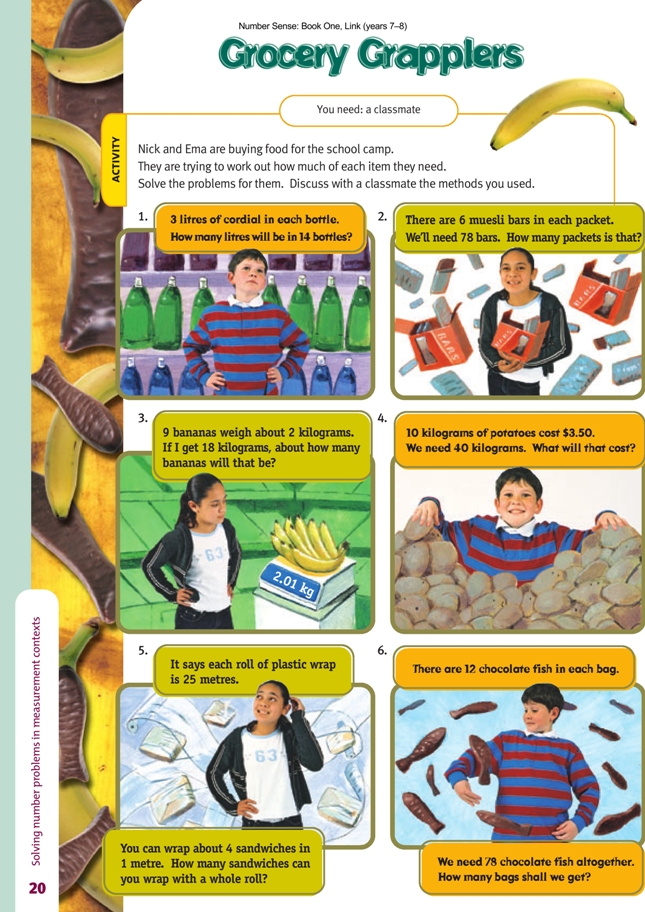This is a level 3 number activity from the Figure It Out series. It relates to Stage 6 of the Number Framework.
A PDF of the student activity is included.
Click on the image to enlarge it. Click again to close. Download PDF (704 KB)
solve multiplication and division problems using basic facts
A classmate
This activity uses measurement contexts to enable students to understand what is happening in the problem.
This will give them clues for deriving the equations they will need.
Ensure that the students understand the importance of the following three key stages of problem solving:
1. Understand the problem.
2. Solve the problem.
3. Evaluate the answer.
If you insist that each group explore each stage and report their findings before moving on to the next stage, the students will come to appreciate the value of each stage. This is best done using problem-solving groups of four students.
The students could use their own words, diagrams, or actions to explain to each other what they think is happening in each problem before they attempt to use numbers in equations or algorithms. Another idea is to have the students list the key words and facts, possibly using headings such as Given, Wanted, and Needed (what I have to do to get the wanted data).
Open or double number lines would help those students who find it difficult to come up with a suitable open number sentence to solve the problem.
Using an open number line to solve problem 1:
.gif)
Using a double number line to solve problem 1:
The students can evaluate their answers by:
• checking that all the important information has been used;
• checking their calculations;
• checking that their answer makes sense.
Encourage the students to share two or three easy or efficient ways to solve the problems. Examples of alternative strategies are shown in the Answers. These alternative strategies show that the essence of problem solving in number is to deliberately manipulate the quantities that make the problem difficult in order to form
easier steps that can be recombined successfully.
Question 6 requires a practical solution in that Nick and Ema need to buy more chocolate fish than they actually need. Six bags of fish gives only 72 fish, so they will need to buy an extra bag of 12 fish to get the 6 fish they need in order to have 78 chocolate fish altogether.
Answers to Activity
1. 42. Two possible methods are:
i. 14 x 3 = 7 x 6 = 42
ii. 10 x 3 = 30, 4 x 3 = 12, 30 + 12 = 42
A possible number line for this method is:
2. 13. Two possible methods are:
i. 6 x 12 = 72, 72 + 6 = 78. That’s 13.
ii. 60 ÷ 6 = 10, 18 ÷ 6 = 3, 10 + 3 = 13
3. 81. Two possible methods are:
i. 18 ÷ 2 = 9 lots of 2 kilograms (9 bananas)
9 x 9 = 81
ii. 4 1/2 bananas per kilogram
18 x 4 1/2 = (18 x 4) + 9
= 72 + 9
= 81
4. $14.00. Two possible methods are:
i. 10 x 4 = 40
4 x $3.50 = 2 x $7.00
= $14.00
ii. 10 x 4 = 40
4 x $3 = $12
4 x 50c = $2
= $14.00
5. 100. Two possible methods are:
i. 25 x 4 = (20 x 4) + (5 x 4) = 80 + 20 = 100
ii. 4 lots of 25 = 100
6. Two possible methods are:
i. 78 ÷ 12 = 6 r6, so 7 bags are needed.
ii. 60 ÷ 12 = 5, 18 ÷ 12 = 11/2 (so they need 2 bags here); 5 + 2 = 7

